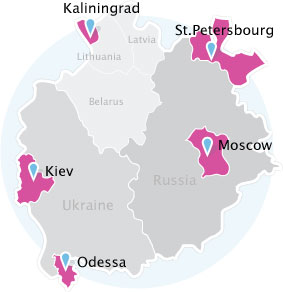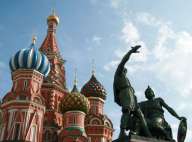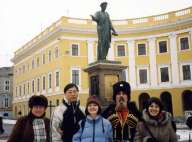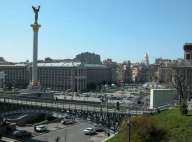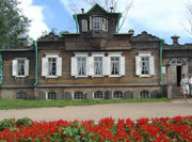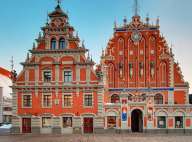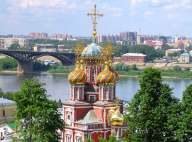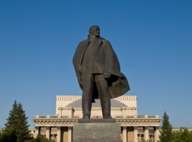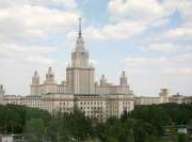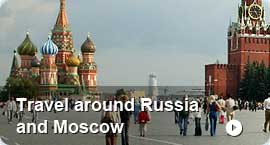Kaliningrad History
Kaliningrad, the ancient Königsberg, has been the scene of fights between Germans and Russians for the domination over the Slavic people.
The Teutonic Knights
 Kaliningrad has been founded by the Teutonic knights when they conquered the coast of the Baltic Sea in the XIIIth century. Poland called them for help in order to repress the uprising of the Bruzi, the inhabitants of this part of the kingdom, whose name is at the origin of the name of Prussia. The Teutonic knights were charged to evangelize the pagan people. Poland had promised to the Great master of the Teutonic order, Hermann von Salza, that the conquered land would belong to the Knights.
Kaliningrad has been founded by the Teutonic knights when they conquered the coast of the Baltic Sea in the XIIIth century. Poland called them for help in order to repress the uprising of the Bruzi, the inhabitants of this part of the kingdom, whose name is at the origin of the name of Prussia. The Teutonic knights were charged to evangelize the pagan people. Poland had promised to the Great master of the Teutonic order, Hermann von Salza, that the conquered land would belong to the Knights.
The Teutonic order is a religious order founded in Jerusalem in 1191 as a hospital. It was turned into a military order in 1198. Its uniform is a large white coat with a black cross. The Great master rules the order and only Germans can become Knights. The order developed itself with the conquest of the Slavic countries situated to the east of the river Oder. The Great master’s residence moved from Venice to Marbork (today in Poland) to Königsberg (in 1456). Since the reformation, it is situated in Vienna. The Great master soon became a Prince of the Holy Empire.
The city of Königsberg has been founded in 1254. The war against the Bruzi had been particularly horrible: the majority of the population had been massacred. The Teutonic knights invited then German and Polish settlers to cultivate the new lands and to inhabit the new founded cities, which were organized as urban republics.
Drang nach Osten
The conquest of these territories is part of the “Drang nach Osten” movement, this German will to extend itself to the east. In April 1242, this movement found its limit with the battle of the Lake Peipous, lying today on the frontier between Estonia and Russia. Alexander Nevski, the Prince of Novgorod, fight and beat the German bearing-sword Knights, who merged later with the Teutonic order.
Alexander Nevski was not sure at all to win the battle because his soldiers were badly equipped in comparison with the German knights. In spite of this disadvantage, the Russian prince did not wait to start with the battle and began the fight on the ice of the Lake Peipous. It was spring and the ice of the lake was already quite thin. The Russian soldiers, who were light-armed infantrymen, easily moved on the ice. In front of them, the German knights, with their heavy weapons and armored horses, did not wait long until they sank in the cold water of the lake.
The Hanseatic League
Konigsberg was a member of the Hanseatic League, an association of German cities, which controlled the trade of the Baltic Sea and beyond. The Hanseatic League benefited from fiscal privileges in foreign countries and owned important counters in Novgorod and London, among others. It trades English fabric, Russian furs, German cereal, etc. The fleet of the League had more than 1000 trade boats at the time of its apogee at the end of the XVth century. The League began to decline with the emergence of the nation states on one part and the Reformation on the other part, which brought deep dissension among its members, not to speak of the 30 years war, which devastated Germany, and the opening of new maritime routes to the far East.
The Kingdom of Prussia
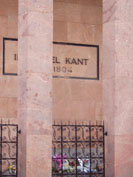 Teutonic Knights’ relationship with the Kingdom of Poland remained harmonious until the middle of the XVth century. However, on July 15th, 1410, after dissension arose between the two of them, a fierce battle began in Tannenberg, which the Knights lost. They had to give in the occidental part of Prussia and to accept Polish suzerainty on the rest of their territory.
Teutonic Knights’ relationship with the Kingdom of Poland remained harmonious until the middle of the XVth century. However, on July 15th, 1410, after dissension arose between the two of them, a fierce battle began in Tannenberg, which the Knights lost. They had to give in the occidental part of Prussia and to accept Polish suzerainty on the rest of their territory.
In 1525, the Great master of the Order was converted to Protestantism. He secularized the possession of the Order and took the title of Duke of Prussia, a hereditary title, which remained under Polish suzerainty. In 1618, the Dukedom was united with Brandeburg, which belonged to the Hohenzollern, thanks to a personal union.
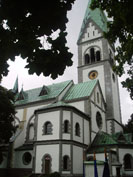 Finally, in 1660, Poland recognized the entire and sole sovereignty of Frederick Whilhelm of Prussia on its Dukedom. On January 18th, 1701, Frederick III Von Hohenzollern was crowned the first King of Prussia in the cathedral of Königsberg and took the name of Frederick I.
Finally, in 1660, Poland recognized the entire and sole sovereignty of Frederick Whilhelm of Prussia on its Dukedom. On January 18th, 1701, Frederick III Von Hohenzollern was crowned the first King of Prussia in the cathedral of Königsberg and took the name of Frederick I.
Königsberg has always been an important city of Prussia. It has been its capital city before Berlin took its place. The philosopher Kant ranked among the professors of its university. Trade between Russia and Germany was at the root of its prosperity. Its port exported cereal (mainly rye and potatoes) and industrial production from the whole region.
Modern Times
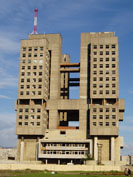 After the German defeat in 1918, the Polish Corridor of Danzig separated East Prussia and Königsberg from the rest of Germany. Hitler’s desire to reunite them was one of the sparks that lit WWII. The three months campaign by which the Red Army took the region in 1945 was one of the fiercest of the war, with hundreds of thousands of casualties on both sides. The Conference of the Allies, which took place in Berlin in 1945, gave East Prussia to USSR.
After the German defeat in 1918, the Polish Corridor of Danzig separated East Prussia and Königsberg from the rest of Germany. Hitler’s desire to reunite them was one of the sparks that lit WWII. The three months campaign by which the Red Army took the region in 1945 was one of the fiercest of the war, with hundreds of thousands of casualties on both sides. The Conference of the Allies, which took place in Berlin in 1945, gave East Prussia to USSR.
Many of the surviving Germans who could not flee in time were killed or sent to Siberia – the last 25’000 were deported to East Germany in 1947-48. Russians came from the entire ex-USSR, especially from Siberia, to settle down in Königsberg. The town has been rebuilt in a typical Soviet style and renamed Kaliningrad after Mikhail Kalinin, the President of the Supreme Soviet during many years, an only honorific position. The old city, which had been flattened by British air raids, has been replaced by beautiful public gardens. Only the cathedral survived: for long time only ruins, it has been rebuilt recently thanks to German patrons.
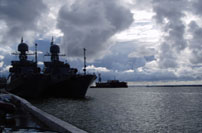 During Soviet time, the region of Kaliningrad was a strategic zone. Many areas were off limits even for locals. Though hundreds of thousands of soldiers have been moved out of the area in the 1990s, the region is still strongly militarized. The port of Baltiysk, at 30 km to the west of the city of Kaliningrad, still headquarters Russia’s Baltic Fleet.
During Soviet time, the region of Kaliningrad was a strategic zone. Many areas were off limits even for locals. Though hundreds of thousands of soldiers have been moved out of the area in the 1990s, the region is still strongly militarized. The port of Baltiysk, at 30 km to the west of the city of Kaliningrad, still headquarters Russia’s Baltic Fleet.
Since some years, the port of Kaliningrad is active again. The region has received the status of a special economical zone and tries to attract foreign investors. The inhabitants are very attached to Moscow and do not want to split off Russia even if the geographical situation of the enclave brings them many disadvantages. With the joining membership of its neighbors Poland and Lithuania to the European Union in 2004, the regulation of transit visas became much more severe and links by road or by rail with Motherland became much more difficult. Let us bet that Kaliningrad, a geopolitical hot point and a Russian piece of land in Central Europe, will remain for some years a subject of dissension between Russia and the European Union.
Amber
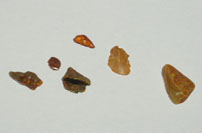 Kaliningrad’s region runs the biggest amber mine in the world, which lies in the village of Yantarny. Amber is a fossilized resin, which is found principally in the sediment of the shores of the Baltic Sea. Scientists began to study it a long time ago: Aristotle described it in his books. However, its systematic study started only during the XVIIIth century.
Kaliningrad’s region runs the biggest amber mine in the world, which lies in the village of Yantarny. Amber is a fossilized resin, which is found principally in the sediment of the shores of the Baltic Sea. Scientists began to study it a long time ago: Aristotle described it in his books. However, its systematic study started only during the XVIIIth century.
The Russian scientist Lomonossov first asserted that it was a resin coming from a tree. Today it is well known that amber is the testimony of the big forests of conifers, which spread in Northern Europe a long time ago.
 Yellow amber is used since the IIIrd millenium for decorative and curative purposes. During the Antiquity, it was the subject of an important trade. A stone borne from water, a stone which imprisons life, with its inclusions of insects, a burning stone, a stone which attracts light objects after craping, amber is an ambiguous material which inspired various legends.
Yellow amber is used since the IIIrd millenium for decorative and curative purposes. During the Antiquity, it was the subject of an important trade. A stone borne from water, a stone which imprisons life, with its inclusions of insects, a burning stone, a stone which attracts light objects after craping, amber is an ambiguous material which inspired various legends.
Our ancestors explained the origin of amber with the history of Phaeton, Hellos’ son. One day, Hellos allowed his son to drive his cart. However, Phaeton, in his clumsiness, drove the cart to close to the earth, putting it into great danger of a terrible drought. In order to stop this disorder, Zeus threw his lightning on the cart.
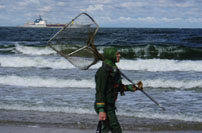 Phaeton fell in a river and died. Gods felt sorry for his sisters’ inconsolable sorrow and transformed them into trees. Young girls’ tears were as much drops of resin, which became pieces of amber.
Phaeton fell in a river and died. Gods felt sorry for his sisters’ inconsolable sorrow and transformed them into trees. Young girls’ tears were as much drops of resin, which became pieces of amber.
This legend and many other beliefs, which attributed magical and curative powers to amber, developed active arts and crafts that are still vivid today in jewelry. For exeample, the Teutonic knights, who held a monopoly on amber, sold rosaries made

